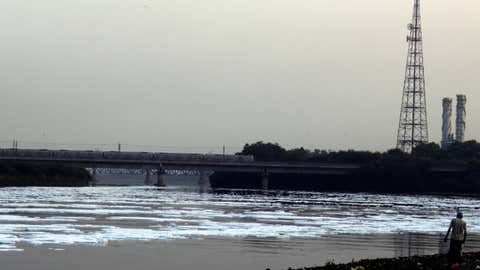
Large amounts of white, toxic foam over the Yamuna river, as seen in New Delhi on Oct 21, 2020.
(IANS)Water quality issues in Delhi’s lifeline, the Yamuna River, is not new. But the sudden spike in ammonia levels above the acceptable levels earlier this week raised many eyebrows. Along with the poisonous air, residents of the capital are complaining about the increased toxic chemical in drinking water. Public health experts have also warned that consuming such water can cause damage to the internal organs, brain, lungs, irritation in eyes, cough and anaemia.
Ammonia is a colourless, pungent compound of Nitrogen and hydrogen, and is present in most water as a biological product of protein decomposition. Its level can spike in surface water sources as a result of industrial or agricultural discharge containing ammonia. The acceptable level of ammonia in the water is 1.7 to 1.9 parts per million (ppm).
On Friday, October 30, ammonia levels shot up to around 3.5 ppm in the Yamuna, which is perceived as an extremely high level of toxicity and is not fit for human consumption. Moreover, an increase in the ammonia level was noted in drinking water supplied to south, east and north-east Delhi. On Saturday, Delhi Jal Board Vice Chairman Raghav Chadha said the utility was working on a war footing to restore normal water supply in Delhi.
Ammonia can lead to severe health complications
"When ammonia enters the body, it affects the blood cells, causes anaemia, affects the nerves and its conduction, affects the brain which can cause early onset of dementia or Alzheimer's," Jugal Kishore, Head of Community Medicine at Safdarjung Hospital, told the news agency IANS. He added, "Long period of exposure to ammonia is dangerous. When it comes to drinking water, people should not use aluminium utensils in the house and use reverse osmosis (RO) filtration method."
Another Delhi-based doctor, Tushar Grover, Medical Director at Vision Eye Centre, said that ammonia in a significant concentration can cause signs of chemical injuries which can cause irritation, discomfort, burning sensation and pain. P. Venkata Krishnan, a doctor of internal medicine at Paras Hospital, warned, "High ammonia level causes irritation in eyes, cough, lung injury, damage to lungs etc. It can cause damage to the internal organs and result in renal failure and respiratory problems. Such water can also be cleaned by the RO technique and not boiling or filtration."
He, however, emphasised that dissolved ammonia toxicity is not very common in humans because it requires large amounts of ammonia to be delivered over a long period of time. "The toxic level of ammonia affects aquatic animals and can contaminate the vegetables grown in that area, especially cauliflower which are grown in the open," he said.
Water from Haryana led to the spike
The Delhi Jal Board has attributed the spike in ammonia levels to the discharge of water from Haryana. DJB's Vice Chairman Raghav Chadha shared the information during an inspection of the Sonia Vihar water treatment plant, one of the two plants where water production had decreased due to an overnight increase in the levels of ammonia.
Chadha inspected the plant after the late Friday evening water crisis in the three districts because the production capacity at Sonia Vihar and Bhagirathi water treatment plants came down to 50 per cent due to the increased ammonia level in the water being discharged from Haryana.
He also held meetings with the concerned engineers, Chief Engineer and Member (Water), to ensure that water production increases to 100 per cent at both the water treatment plants. Both the plants have a collective capacity of 250 MGD. Water from these plants reaches areas in south Delhi, East Delhi and north-east Delhi and parts of the NDMC area.
The Vice-Chairman issued a statement detailing the reasons for the ammonia increase, saying "Delhi is a landlocked city and gets water from the neighbouring states. Due to annual maintenance, water coming from Uttar Pradesh, that is from Ganga, has stopped. This happens every October. Unfortunately, this maintenance work has coincided with the incidence of water that is released from Haryana into River Yamuna. Now, due to the discharge of that water from Haryana, the level of ammonia increased."
Chadha explained that the level of ammonia in the water should be somewhere between 1.7 PPM to 1.9 PPM (Parts Per Million). "Yesterday (Friday), this had gone up to almost 3.5 PPM, which is perceived as an extremely high level of toxicity and is not fit for human consumption. As a result, the two significant water treatment plants at Sonia Vihar and Bhagirathi, which treat the water that comes in from River Yamuna, had to be shut."
Delhi Jal Board is using pumps and other machinery at different locations to pump the water from one place to another in the Yamuna, the leader said, adding that this will remove the stagnated water with increased ammonia, which will be replaced with the water that will come from Haryana through the Yamuna and from Uttar Pradesh through its emergent alternate route up to the affected plants.
(with inputs from IANS)
**
For weather, air pollution, science, and COVID-19 updates on the go, download The Weather Channel App (on Android and iOS store). It's free!
"severe" - Google News
November 01, 2020 at 08:18PM
https://ift.tt/3jRfdQJ
Increased Ammonia in Water Can lead to Severe Health Impacts, Say Experts; Delhi Jal Board Blames Water from Haryana | The Weather Channel - Articles from The Weather Channel | weather.com - The Weather Channel
"severe" - Google News
https://ift.tt/2OrY17E
Shoes Man Tutorial
Pos News Update
Meme Update
Korean Entertainment News
Japan News Update
Bagikan Berita Ini















0 Response to "Increased Ammonia in Water Can lead to Severe Health Impacts, Say Experts; Delhi Jal Board Blames Water from Haryana | The Weather Channel - Articles from The Weather Channel | weather.com - The Weather Channel"
Post a Comment